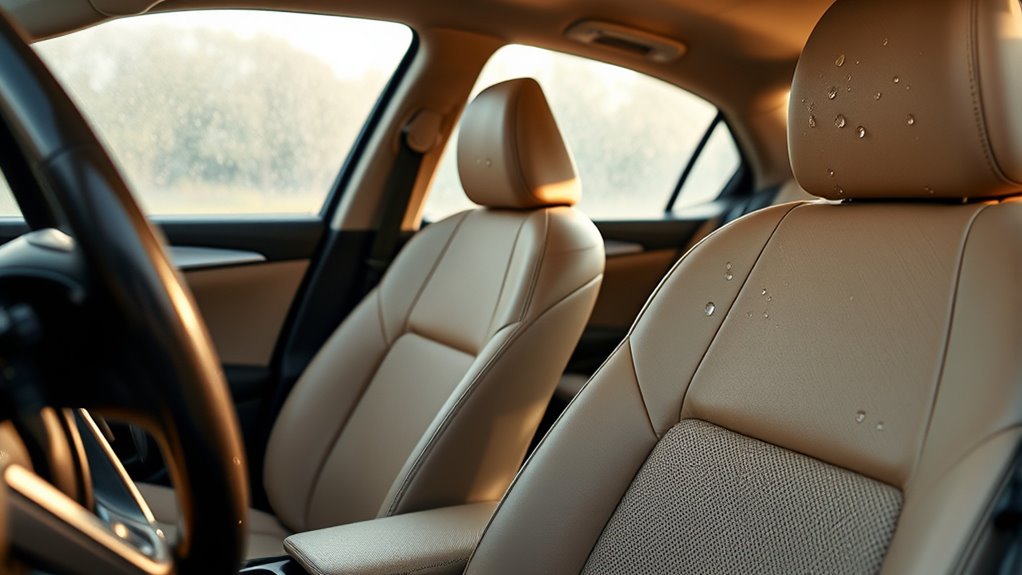High humidity inside your car can lead to mold growth, causing musty odors and damage to fabrics, leather, and plastics. Moisture weakens fibers, accelerates cracking, and clouds surface colors, making your interior look worn out. It also encourages mold patches and sticky or brittle plastic parts. Using your climate control, maintaining proper ventilation, and staying proactive can reduce these issues. To protect your car further, discover effective strategies to minimize humidity’s impact on your interior.
Key Takeaways
- High humidity promotes mold growth on fabrics, upholstery, and interior surfaces.
- Excess moisture causes fabrics, leather, and plastics to deteriorate and crack over time.
- Moist conditions lead to unpleasant odors and reduce the lifespan of interior materials.
- Humidity accelerates material discoloration, brittleness, and surface damage.
- Proper climate control and ventilation help manage humidity and prevent interior degradation.

High humidity levels can considerably impact your car’s interior, leading to issues like mold growth, musty odors, and fabric deterioration. When the air inside your vehicle stays humid for extended periods, it creates an ideal environment for moisture to settle into fabrics, carpets, and even the dashboard. Without proper climate control, this excess moisture doesn’t evaporate easily, setting the stage for material degradation over time. Humidity accelerates the breakdown of materials such as leather, vinyl, and plastics, causing them to become brittle, cracked, or discolored.
High humidity inside your car promotes mold, odors, and material deterioration over time.
One of the most effective ways to combat these problems is by maintaining good climate control within your car. Air conditioning systems aren’t just for cooling—they also help regulate humidity levels by removing excess moisture from the air. When you turn on your climate control, it pulls in moist air, cools it, and reduces the relative humidity inside the vehicle. This process prevents the buildup of dampness that could otherwise lead to mold growth and musty smells. Regularly using your air conditioning system, especially in humid environments, is essential for preserving your car’s interior.
Material degradation is another critical issue caused by high humidity. Fabrics, such as seat upholstery and carpeting, absorb moisture, which weakens their fibers over time. This can lead to fraying, mold spots, and unpleasant odors that are difficult to eliminate. Leather and vinyl surfaces are also vulnerable; excess moisture can cause these materials to crack, peel, or develop mold patches, compromising both their appearance and longevity. Even plastics and rubber components can suffer from prolonged exposure to humidity, becoming sticky or brittle, which affects their functionality.
To minimize humidity-related damage, you should pay attention to your car’s ventilation. Make sure your windows and vents are functioning correctly, and consider using dehumidifiers designed for automotive use if you frequently park in very humid areas. Regularly cleaning and drying your interior surfaces helps prevent moisture buildup. Additionally, parking in shaded or sheltered areas reduces temperature fluctuations that can cause condensation inside the vehicle. By controlling climate and moisture levels diligently, you preserve your car’s interior in its best condition, preventing the accelerated material degradation caused by high humidity.
Frequently Asked Questions
Can Humidity Levels Cause Mold Growth Inside My Car?
Yes, high humidity levels can cause mold growth inside your car. To prevent mold, focus on moisture control by regularly airing out your vehicle and using dehumidifiers if needed. Keep the interior dry and clean to discourage mold formation. Proper mold prevention involves managing humidity and moisture inside the car, which helps protect your upholstery and keeps the environment fresh and safe for occupants.
How Can I Reduce Humidity in My Car Effectively?
To reduce humidity in your car effectively, you should improve ventilation techniques by opening windows or using vents when possible. Additionally, place moisture absorbers like silica gel packs or activated charcoal in your vehicle to absorb excess moisture. Regularly clean your car’s interior and keep it dry. These steps help maintain a balanced humidity level, preventing mold growth and keeping your car’s interior fresh and comfortable.
Does Humidity Affect My Car’s Paint or Exterior?
Humidity can harm your car’s paint and exterior by causing paint corrosion and speeding up exterior fading. When moisture sits on your car’s surface, it promotes rust and weakens the protective coating. To prevent this, regularly wash and wax your car, park in shaded areas, and use a car cover if possible. Keeping humidity levels low helps preserve your car’s finish and extends its lifespan.
Are There Specific Materials More Vulnerable to Humidity Damage?
Certain materials, like fabric upholstery and leather, are more vulnerable to humidity damage. High humidity accelerates material degradation, causing fabrics to mold and deteriorate faster, while leather can develop mold or become brittle. You should regularly check these materials for signs of fabric deterioration or mold and consider using moisture barriers or dehumidifiers inside your car. Proper maintenance helps prevent humidity-related damage and keeps your interior in good shape.
Can Humidity Impact My Car’s Electronic Components?
Coincidentally, humidity can definitely impact your car’s electronic components. Moisture buildup causes electronic corrosion over time, which can lead to malfunctions or failures. When humidity levels rise, it creates a perfect environment for moisture to seep into sensitive parts, accelerating corrosion and damaging circuits. To protect your vehicle, make certain of proper sealing and ventilation, and consider using moisture-absorbing products, especially in high-humidity areas.
Conclusion
Understanding how humidity impacts your car’s interior helps you keep it in top shape. By managing moisture levels, you prevent mold, musty smells, and damage to upholstery and electronics. Think of maintaining proper humidity like tending to a fine garden—attention now saves you trouble later. So, don’t forget to use dehumidifiers or vent properly; your car will thank you. Remember, even in the age of steam, a dry interior kept everything running smoothly!








